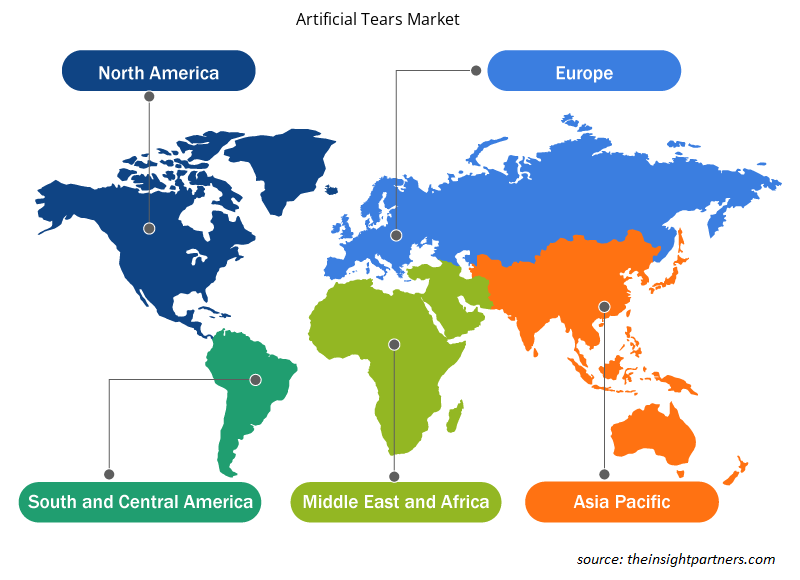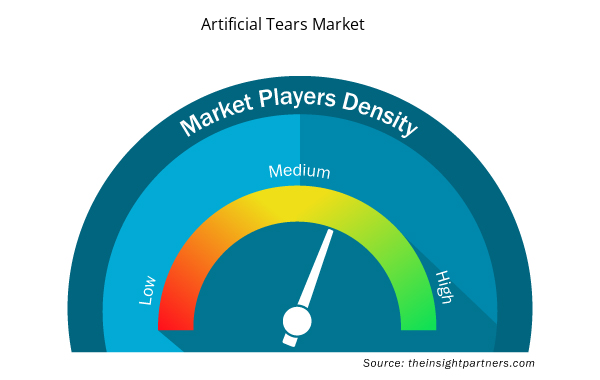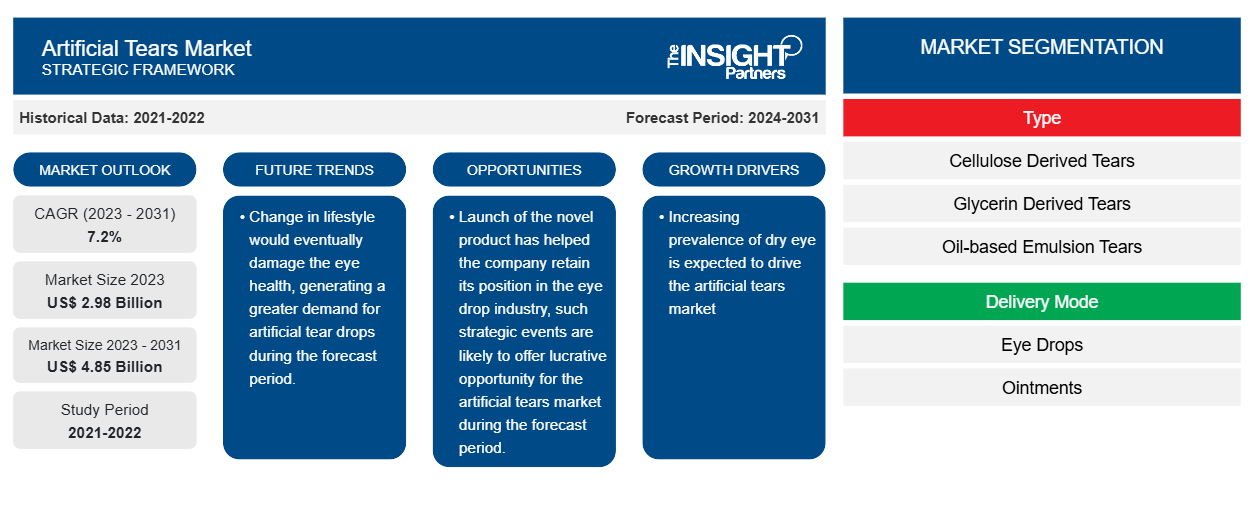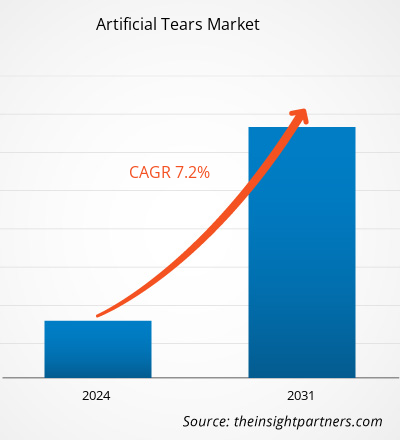人工涙液市場規模は、2023年の29億8,000万米ドルから2031年には48億5,000万米ドルに達すると予測されています。市場は2023年から2031年の間に7.2%のCAGRを記録すると予想されています。ライフスタイルの変化は、今後も市場の主要なトレンドであり続けると思われます。
人工涙液市場分析
ドライアイの発症率の上昇と人口の高齢化が、市場発展の重要な原動力となっています。さらに、産業開発の増加は、人工涙液市場のプレーヤーにとって重要な機会です。
人工涙液市場の概要
ドライアイの発生率は、特に先進国で増加しています。ドライアイは、不快感、刺激、視覚障害を引き起こす複数の要因によって引き起こされます。たとえば、2020年4月に米国で実施された調査「国民健康・ウェルネス調査」によると、約1,640万人がドライアイと診断されました。データによると、18〜34歳の人の有病率は2.7%増加しています。さらに、高齢者の有病率は18.6%でした。性別に基づくと、有病率は女性の方が高く、男性の4.5%よりも8.8%を占めています。ドライアイの発生率は、ヨーロッパとアジア太平洋地域の人口で高くなっています。したがって、ドライアイの有病率の増加が人工涙液市場を牽引すると予想されます。
要件に合わせてレポートをカスタマイズする
このレポートの一部、国レベルの分析、Excelデータパックなど、あらゆるレポートを無料でカスタマイズできます。また、スタートアップや大学向けのお得なオファーや割引もご利用いただけます。
- このレポートの主要な市場動向を入手してください。この無料サンプルには、市場動向から見積もりや予測に至るまでのデータ分析が含まれます。
人工涙液市場の推進要因と機会
高齢化人口の増加
ドライアイの発症は、65歳以上の人によく見られます。高齢者人口は世界中で急増しています。2019年改訂版の世界人口見通しによると、2050年までに6人に1人が65歳以上になり、2019年の11人に1人から増加します。さらに、同じ調査によると、ヨーロッパと北米では2050年までに4人に1人が65歳以上になると推定されています。さらに、80歳以上の人口は、2019年の1億4,300万人から2050年には4億2,600万人に達するでしょう。加齢は、目の視力を弱める主な要因の1つです。さまざまなヘルスケア企業が、高齢者人口に焦点を当てて製品を設計しています。高齢者の退化プロセスははるかに速いため、目の病気にかかりやすい傾向があります。したがって、高齢者の間でドライアイの有病率が高いことから、メーカーは新しい目の製品の導入を促し、それが市場の成長に貢献する可能性があります。また、ヘルスケア業界の発展により、平均寿命は延びています。世界中の国々が、高齢者を安全かつ効果的に治療するための新しい技術を導入しています。そのため、生活の質の向上により死亡率が低下し、高齢者人口は世界中で大幅に増加しています。これにより、市場の成長が促進されると予想されます。
産業開発の増加
業界では、市場に非常に有利な成長機会を生み出している多くのビジネス活動が目撃されています。業界のプレーヤーは、ブランドの確立とサプライチェーンの流通チャネルの統合に注力し、世界市場での存在感を高めています。たとえば、2020年3月、グラフトンオプティカルは、重度の慢性蒸発性ドライアイを緩和するI-DROP MGD粘性適応性涙液を発売しました。I-DROP MGDは防腐剤を含まない人工涙液で、マイボーム腺機能不全の患者の蒸発性ドライアイに伴う症状の緩和に役立ちます。これは、角膜の水分補給と潤滑のための最も先進的な点眼薬です。さらに、企業は市場で先進的な製品を発売するために積極的に取り組んでいます。たとえば、2020年3月、アイケアの世界的リーダーであるアルコンは、ドライアイ用のSYSTANE HYDRATION防腐剤を含まない(PF)潤滑点眼薬を発売しました。これは、目の乾燥を和らげ、さらなる刺激から保護するために使用されます。
さらに、2019年10月、アラガンはリフレッシュ リリーバ 潤滑剤アイと呼ばれる新製品ラインを発売しました。この斬新な製品の発売により、同社は点眼薬業界での地位を維持することができました。このような戦略的なイベントは、予測期間中に人工涙液市場に有利な成長機会をもたらす可能性があります。
人工涙液市場レポートのセグメンテーション分析
人工涙液市場分析の導出に貢献した主要なセグメントは、タイプ、投与、および適用です。
- タイプに基づいて、人工涙液市場は、セルロース由来の涙液、グリセリン由来の涙液、油性エマルジョン涙液、ポリエチレングリコールベースの涙液、プロピレングリコールベースの涙液、ヒアルロン酸ナトリウムベースの人工涙液に分類されます。グリセリン由来の涙液セグメントは、2023年に最も重要な市場シェアを占めました。
- 投与方法に基づいて、人工涙液市場は点眼薬、軟膏に分類されます。グリセリン由来の涙液セグメントは、2023年に最も重要な市場シェアを占めました。
- 用途別に見ると、人工涙液市場はドライアイ治療、コンタクトレンズ保湿に分類されます。ドライアイ治療セグメントは2023年に最大の市場シェアを占めました。
人工涙液市場シェアの地域別分析
人工涙液市場レポートの地理的範囲は、主に北米、アジア太平洋、ヨーロッパ、中東およびアフリカ、南米および中米の 5 つの地域に分かれています。
北米では、米国の人工涙液市場が同地域で最大のシェアを占めています。米国は、北米地域で人工涙液市場が最大かつ最も急速に成長している国です。ドライアイの状態や疾患の発生率の増加により、市場の成長が見込まれています。米国には、ドライアイの状態を治療するための複数の種類の点眼薬やレンズを提供するさまざまな企業があります。また、医療費の増加も同国の市場の成長に影響を与えています。2019年の米国眼科学会のデータによると、2012年には、ドライアイの状態の有病率がすべての年齢層で5.28%増加しました。女性の割合は7.78%増加し、男性では2.96%増加しました。
ドライアイ患者の割合が増加しているため、人工涙液製品の需要が増加すると予想されています。さらに、国内ではドライアイ治療に対する医療費が増加しています。たとえば、JAMA 内科医学誌に掲載された記事によると、政府はドライアイの治療に年間 20 億ドル以上を費やしています。
人工涙液市場の地域別分析
予測期間を通じて人工涙液市場に影響を与える地域的な傾向と要因は、Insight Partners のアナリストによって徹底的に説明されています。このセクションでは、北米、ヨーロッパ、アジア太平洋、中東、アフリカ、南米、中米にわたる人工涙液市場のセグメントと地理についても説明します。

- 人工涙液市場の地域別データを入手
人工涙液市場レポートの範囲
| レポート属性 | 詳細 |
|---|---|
| 2023年の市場規模 | 29億8千万米ドル |
| 2031年までの市場規模 | 48.5億米ドル |
| 世界のCAGR(2023年~2031年) | 7.2% |
| 履歴データ | 2021-2022 |
| 予測期間 | 2024-2031 |
| 対象セグメント | タイプ別
|
| 対象地域と国 | 北米
|
| 市場リーダーと主要企業プロフィール |
|
人工涙液市場のプレーヤー密度:ビジネスダイナミクスへの影響を理解する
人工涙液市場は、消費者の嗜好の変化、技術の進歩、製品の利点に対する認識の高まりなどの要因により、エンドユーザーの需要が高まり、急速に成長しています。需要が高まるにつれて、企業は提供品を拡大し、消費者のニーズを満たすために革新し、新たなトレンドを活用し、市場の成長をさらに促進しています。
市場プレーヤー密度とは、特定の市場または業界内で活動している企業または会社の分布を指します。これは、特定の市場スペースに、その規模または総市場価値と比較して、どれだけの競合相手 (市場プレーヤー) が存在するかを示します。
人工涙液市場で事業を展開している主要企業は次のとおりです。
- ジョンソンサービス株式会社
- アルコン株式会社
- オアシスメディカル
- アッヴィ株式会社
- バイエルAG
- プレステージ コンシューマー ヘルスケア株式会社
免責事項:上記の企業は、特定の順序でランク付けされていません。

- 人工涙液市場のトップキープレーヤーの概要を入手
人工涙液市場のニュースと最近の動向
人工涙液市場は、主要な企業出版物、協会データ、データベースを含む一次および二次調査後の定性的および定量的データを収集することによって評価されます。人工涙液市場の動向のいくつかを以下に示します。
- サンファーマは、ドライアイ(DED)患者の治療を目的とした眼科専門治療薬「CEQUA」をインドで発売した。(出典:サンファーマ、同社ウェブサイト、2023年4月)
人工涙液市場レポートのカバー範囲と成果物
「人工涙液市場規模と予測(2021〜2031年)」レポートでは、以下の分野をカバーする市場の詳細な分析を提供しています。
- 対象範囲に含まれるすべての主要市場セグメントについて、世界、地域、国レベルでの非経口栄養市場の規模と予測
- 経腸栄養市場の動向、推進要因、制約、主要な機会などの市場動向
- 詳細なPEST/ポーターの5つの力とSWOT分析
- 主要な市場動向、世界および地域の枠組み、主要プレーヤー、規制、最近の市場動向を網羅した非経口栄養市場分析。
- 市場集中、ヒートマップ分析、主要プレーヤー、人工涙液市場の最近の動向を網羅した業界の状況と競争分析
- 詳細な企業プロフィール
- 過去2年間の分析、基準年、CAGRによる予測(7年間)
- PEST分析とSWOT分析
- 市場規模価値/数量 - 世界、地域、国
- 業界と競争環境
- Excel データセット



Report Coverage
Revenue forecast, Company Analysis, Industry landscape, Growth factors, and Trends

Segment Covered
This text is related
to segments covered.

Regional Scope
North America, Europe, Asia Pacific, Middle East & Africa, South & Central America

Country Scope
This text is related
to country scope.
よくある質問
The market is expected to register a CAGR of 7.2% during 2023–2031.
Johnson Services, Inc., Alcon Inc., OASIS Medical, AbbVie Inc., Bayer AG, Prestige Consumer Healthcare Inc., Santen Pharmaceutical Co., Ltd., Bausch Health Companies Inc., Akorn, Incorporated, Aurolab.
Changes in Lifestyle will likely remain a key trend in the market.
Key factors driving market growth are rising incidence of dry eye and the growing older population. However, poor accessibility to eye care services in low-income countries hamper the market growth.
North America dominated the artificial tears market in 2023
Trends and growth analysis reports related to Life Sciences : READ MORE..
The Insight Partners performs research in 4 major stages: Data Collection & Secondary Research, Primary Research, Data Analysis and Data Triangulation & Final Review.
- Data Collection and Secondary Research:
As a market research and consulting firm operating from a decade, we have published and advised several client across the globe. First step for any study will start with an assessment of currently available data and insights from existing reports. Further, historical and current market information is collected from Investor Presentations, Annual Reports, SEC Filings, etc., and other information related to company’s performance and market positioning are gathered from Paid Databases (Factiva, Hoovers, and Reuters) and various other publications available in public domain.
Several associations trade associates, technical forums, institutes, societies and organization are accessed to gain technical as well as market related insights through their publications such as research papers, blogs and press releases related to the studies are referred to get cues about the market. Further, white papers, journals, magazines, and other news articles published in last 3 years are scrutinized and analyzed to understand the current market trends.
- Primary Research:
The primarily interview analysis comprise of data obtained from industry participants interview and answers to survey questions gathered by in-house primary team.
For primary research, interviews are conducted with industry experts/CEOs/Marketing Managers/VPs/Subject Matter Experts from both demand and supply side to get a 360-degree view of the market. The primary team conducts several interviews based on the complexity of the markets to understand the various market trends and dynamics which makes research more credible and precise.
A typical research interview fulfils the following functions:
- Provides first-hand information on the market size, market trends, growth trends, competitive landscape, and outlook
- Validates and strengthens in-house secondary research findings
- Develops the analysis team’s expertise and market understanding
Primary research involves email interactions and telephone interviews for each market, category, segment, and sub-segment across geographies. The participants who typically take part in such a process include, but are not limited to:
- Industry participants: VPs, business development managers, market intelligence managers and national sales managers
- Outside experts: Valuation experts, research analysts and key opinion leaders specializing in the electronics and semiconductor industry.
Below is the breakup of our primary respondents by company, designation, and region:

Once we receive the confirmation from primary research sources or primary respondents, we finalize the base year market estimation and forecast the data as per the macroeconomic and microeconomic factors assessed during data collection.
- Data Analysis:
Once data is validated through both secondary as well as primary respondents, we finalize the market estimations by hypothesis formulation and factor analysis at regional and country level.
- Macro-Economic Factor Analysis:
We analyse macroeconomic indicators such the gross domestic product (GDP), increase in the demand for goods and services across industries, technological advancement, regional economic growth, governmental policies, the influence of COVID-19, PEST analysis, and other aspects. This analysis aids in setting benchmarks for various nations/regions and approximating market splits. Additionally, the general trend of the aforementioned components aid in determining the market's development possibilities.
- Country Level Data:
Various factors that are especially aligned to the country are taken into account to determine the market size for a certain area and country, including the presence of vendors, such as headquarters and offices, the country's GDP, demand patterns, and industry growth. To comprehend the market dynamics for the nation, a number of growth variables, inhibitors, application areas, and current market trends are researched. The aforementioned elements aid in determining the country's overall market's growth potential.
- Company Profile:
The “Table of Contents” is formulated by listing and analyzing more than 25 - 30 companies operating in the market ecosystem across geographies. However, we profile only 10 companies as a standard practice in our syndicate reports. These 10 companies comprise leading, emerging, and regional players. Nonetheless, our analysis is not restricted to the 10 listed companies, we also analyze other companies present in the market to develop a holistic view and understand the prevailing trends. The “Company Profiles” section in the report covers key facts, business description, products & services, financial information, SWOT analysis, and key developments. The financial information presented is extracted from the annual reports and official documents of the publicly listed companies. Upon collecting the information for the sections of respective companies, we verify them via various primary sources and then compile the data in respective company profiles. The company level information helps us in deriving the base number as well as in forecasting the market size.
- Developing Base Number:
Aggregation of sales statistics (2020-2022) and macro-economic factor, and other secondary and primary research insights are utilized to arrive at base number and related market shares for 2022. The data gaps are identified in this step and relevant market data is analyzed, collected from paid primary interviews or databases. On finalizing the base year market size, forecasts are developed on the basis of macro-economic, industry and market growth factors and company level analysis.
- Data Triangulation and Final Review:
The market findings and base year market size calculations are validated from supply as well as demand side. Demand side validations are based on macro-economic factor analysis and benchmarks for respective regions and countries. In case of supply side validations, revenues of major companies are estimated (in case not available) based on industry benchmark, approximate number of employees, product portfolio, and primary interviews revenues are gathered. Further revenue from target product/service segment is assessed to avoid overshooting of market statistics. In case of heavy deviations between supply and demand side values, all thes steps are repeated to achieve synchronization.
We follow an iterative model, wherein we share our research findings with Subject Matter Experts (SME’s) and Key Opinion Leaders (KOLs) until consensus view of the market is not formulated – this model negates any drastic deviation in the opinions of experts. Only validated and universally acceptable research findings are quoted in our reports.
We have important check points that we use to validate our research findings – which we call – data triangulation, where we validate the information, we generate from secondary sources with primary interviews and then we re-validate with our internal data bases and Subject matter experts. This comprehensive model enables us to deliver high quality, reliable data in shortest possible time.


 このレポートの無料サンプルを入手する
このレポートの無料サンプルを入手する